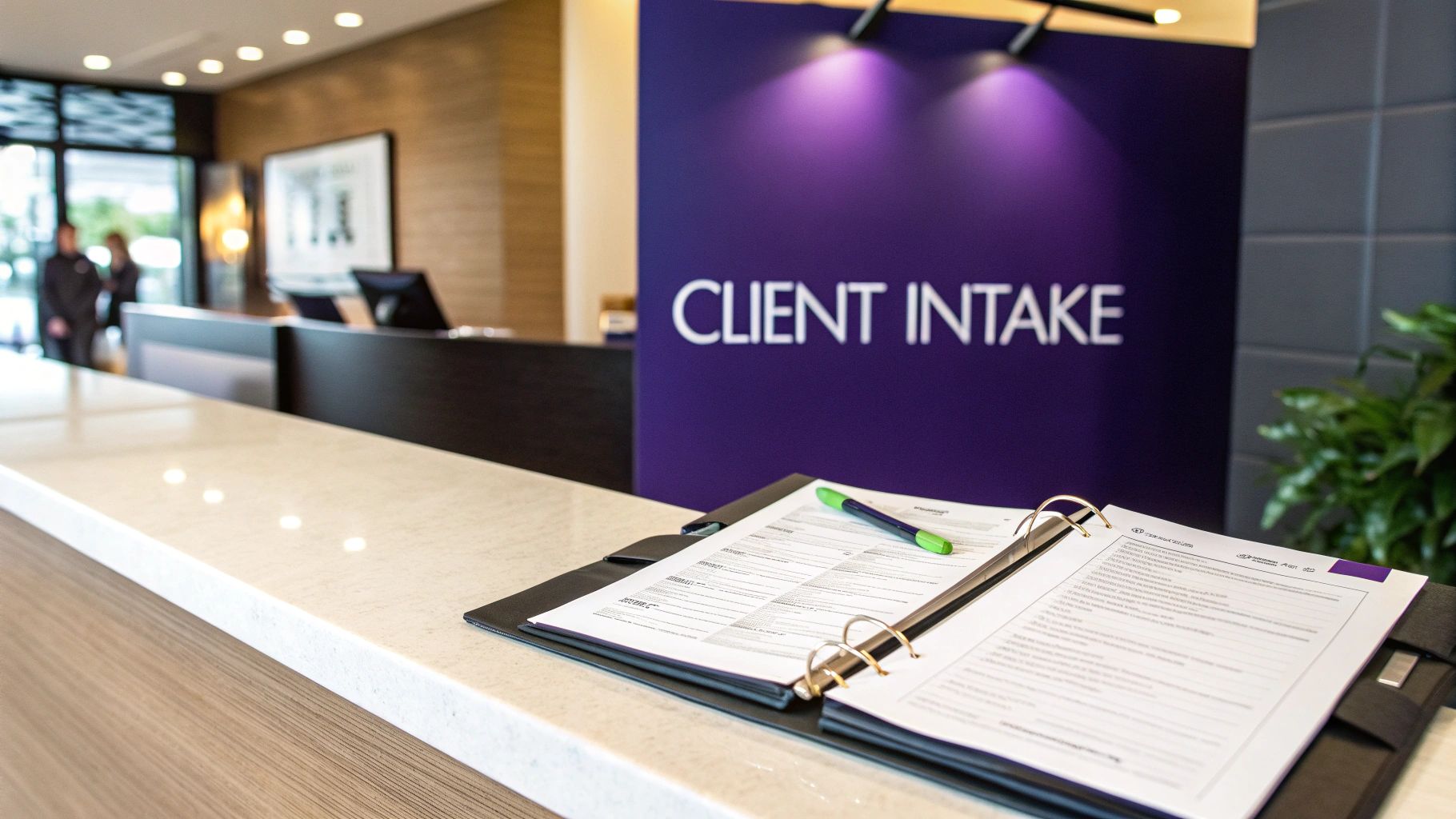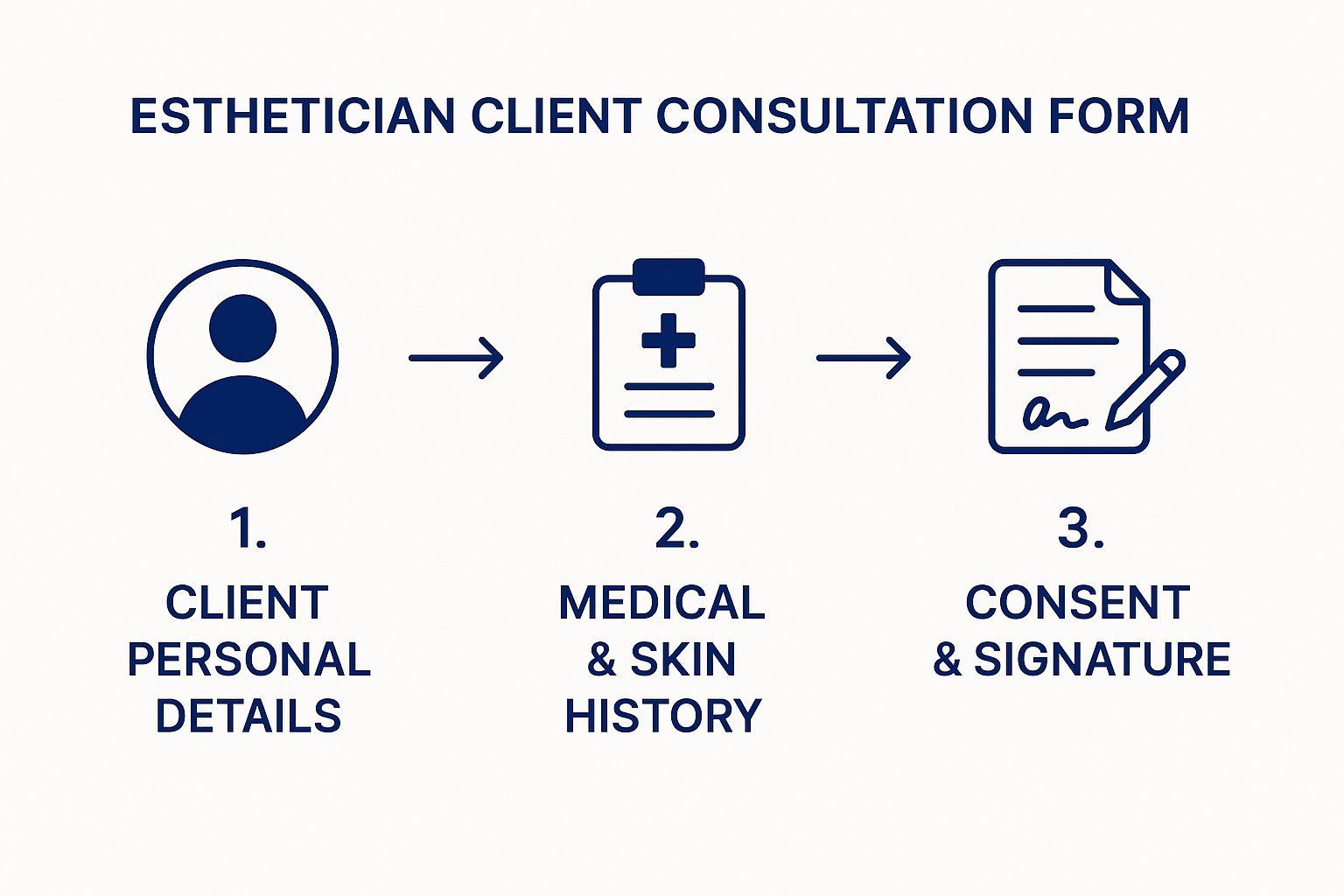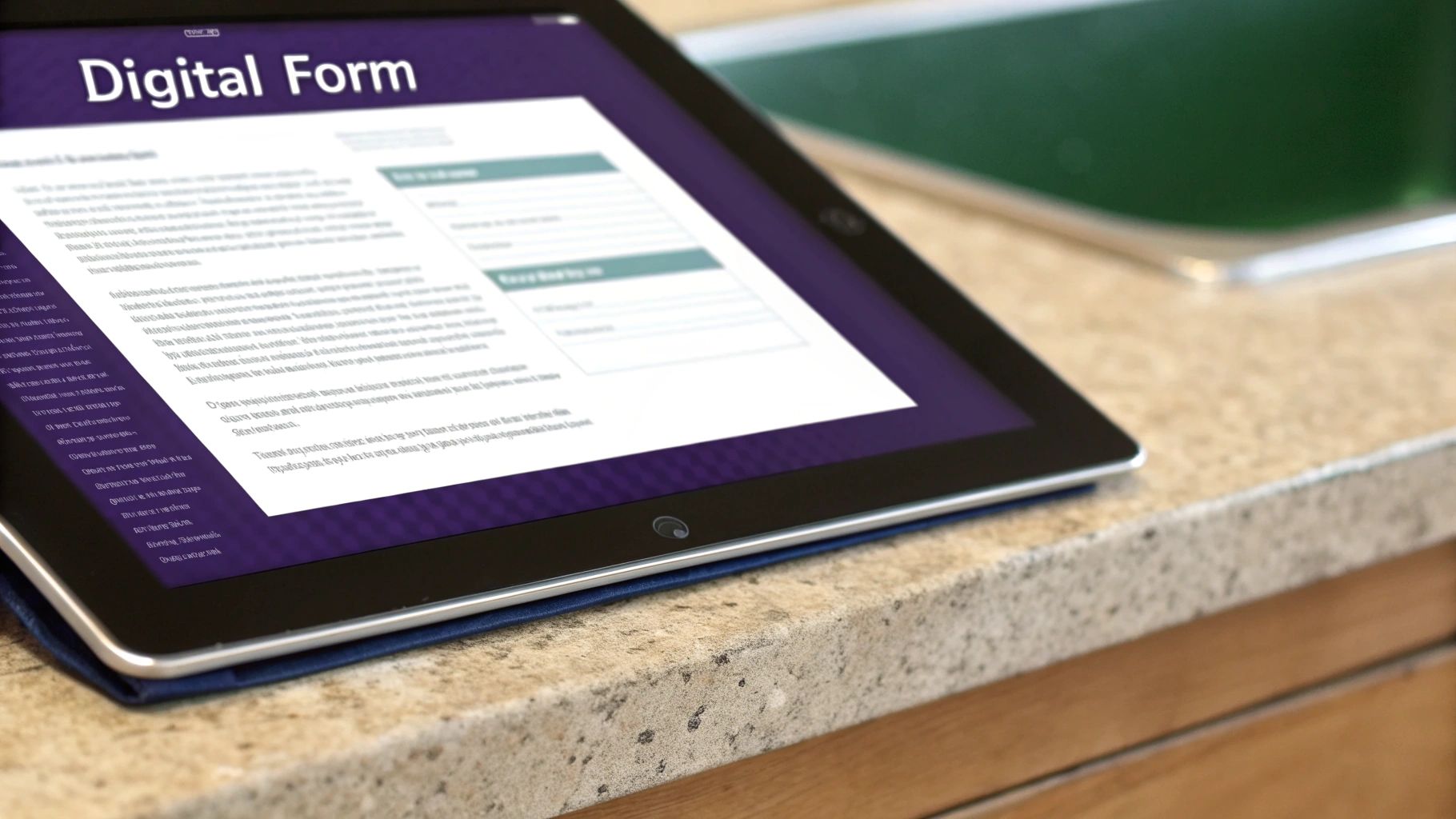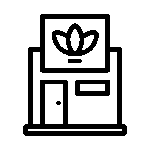Build Better Esthetician Client Consultation Forms

An esthetician client consultation form is hands-down your most important tool for building a safe, professional, and successful practice. It’s a detailed questionnaire clients fill out before their very first service, giving you a complete rundown of their health, skin history, lifestyle, and goals.
This isn't just paperwork. It's the intel you need to customize treatments and, most importantly, avoid any potential adverse reactions.
Your Foundation for Client Trust and Safety

Think of your consultation form as the very cornerstone of the client relationship. It’s your first real chance to show off your expertise, build that initial layer of trust, and protect both your client and your business.
A solid form is what turns a generic facial into a truly personalized, effective treatment plan. It sets a professional standard from the moment they walk in (or fill it out online). It shows you genuinely care about their unique needs and history, which immediately mitigates risks and paves the way for a loyal, long-term relationship.
Why These Forms Are More Important Than Ever
Let's be real: the demand for personalized skincare has absolutely exploded. Clients don't just want a facial; they want their facial. This trend is a huge part of the industry's growth—the global professional beauty services market was valued at a massive USD 247.24 billion in 2023 and is on track to hit USD 395.69 billion by 2030.
This boom means you're dealing with a savvier client base that expects customized care. And that level of care always starts with a thorough consultation.
A great esthetician client consultation form does more than just collect data—it screams, "I see you, I understand your needs, and I am 100% prepared to deliver the best possible care for your skin."
This document is your first line of defense and your best tool for creating those "wow" results. Here's the actionable insight: a well-built form allows you to:
- Actionable Step: Identify Contraindications: Use your form to pinpoint allergies, medications, or medical conditions that could make certain treatments unsafe. This is your primary risk-management tool.
- Actionable Step: Tailor Services: Get the inside scoop on their skin type, biggest concerns, and ultimate goals so you can choose the most effective products and techniques for a truly custom service.
- Actionable Step: Manage Expectations: Document what they hope to achieve and have an honest conversation about what's realistically possible, preventing future disappointment.
- Actionable Step: Build Professional Trust: Showing this level of detail and care from the get-go instantly establishes your credibility and expertise.
Ultimately, this form is a critical extension of your business's online presence. Just like a beautiful, user-friendly website attracts clients, a thoughtful and professional form solidifies their decision to trust you with their skin. If you're looking to polish that entire client journey, from their first click to their first treatment, check out our guide on powerful contact page design. It’s all about creating a seamless, professional experience at every single touchpoint.
Building Your Form Question by Question
Crafting the perfect esthetician client consultation form isn’t about asking a million questions. It’s about asking the right ones. A truly great form gets you the critical information you need to deliver a safe, personalized treatment without making your new client feel like they’re filling out tax paperwork.
The goal is to ditch generic templates and create a document that becomes a cornerstone of your practice. It needs to be thorough but not overwhelming, setting the stage for open, honest communication.
Think of it as a three-part journey:
- The Basics: Personal and Medical History
- The Details: Skincare, Lifestyle, and Goals
- The Legalities: Consent and Liability

This logical flow—starting with personal details, moving into health history, and wrapping up with consent—is what separates a clunky intake process from a seamless one.
The Non-Negotiables: Personal and Medical History
This is where your duty of care starts. This section is all about safety and sniffing out potential contraindications before they become a problem.
Actionable Tip: Don't just have a single, vague field for "Allergies." Get specific with checklists or targeted questions to get accurate answers. Implement these questions for better screening:
- Do you have any known allergies to nuts, latex, aspirin, or specific cosmetic ingredients (like fragrances or preservatives)?
- Are you currently pregnant, trying to conceive, or breastfeeding?
- Please list all medications you take, both topical and oral. This includes prescriptions, over-the-counter drugs, and even supplements.
Why the detail? Because a client might not think to mention their daily low-dose aspirin, but a direct question jogs their memory. This level of detail isn't just good practice; it's modern risk management.
The Fun Part: Skincare, Lifestyle, and Goals
Once you've covered the safety bases, you can dive into what brought them to you in the first place. This is where you put on your skin detective hat and uncover the intel you need to deliver those "wow" results.
Actionable Tip: Specific questions get you much further than generic ones. Ask these to get the best information:
- What are your top three skin concerns right now? (e.g., acne, fine lines, redness, dark spots)
- On a scale of 1 to 5, how sensitive would you say your skin is?
- Tell me about your daily sun exposure. Are you mostly indoors, outside frequently, a daily sunscreen user?
- How are your stress levels and sleep patterns lately?
When you ask about lifestyle factors like diet, stress, and sleep, you’re showing a deeper, more holistic understanding of skin health. It proves you know that what’s happening on the inside is just as important as the products they’re using.
This isn’t just a hunch; it’s backed by industry best practices. The most effective forms today are designed to capture 20–30 detailed data points for each client, painting a complete picture of their health, habits, and goals. This kind of thorough documentation is a powerful tool for risk management. In fact, some studies show it can help slash the risk of adverse reactions by up to 90% during professional treatments. You can always explore additional insights on building these essential forms to better protect your practice and your clients.
To help you decide what to include, I’ve broken down questions into "essential" and "advanced" categories. Start with the essentials and add the advanced questions as you expand your services or want to offer more in-depth consultations.
Essential vs. Advanced Form Questions
| Category | Essential (Must-Have) Questions | Advanced (Good-to-Have) Questions |
|---|---|---|
| Contact & Personal Info | Full Name, Phone, Email, DOB, How did you hear about us? | Occupation, Emergency Contact |
| Medical History | Allergies (food, latex, ingredients), Current Medications (oral/topical), Pregnancy/Breastfeeding status, Recent Surgeries, Known medical conditions (e.g., epilepsy, diabetes) | Use of Retinoids/Accutane, History of cold sores (Herpes Simplex Virus), Use of blood thinners, Autoimmune disorders |
| Skincare Routine | Current products used (cleanser, moisturizer, SPF), Top 3 skin concerns, Skin type (self-assessed: oily, dry, combo) | How often do you exfoliate?, What brands do you use?, Have you ever had a professional treatment before? |
| Lifestyle Factors | Daily sun exposure & SPF use, Do you smoke?, General water intake | Diet habits (e.g., high sugar, dairy), Stress levels (1-10 scale), Typical sleep hours per night, Exercise frequency |
| Goals & Consent | What are your goals for today's treatment?, What are your long-term skin goals?, Signature for treatment consent & photo release | Budget for home care products, Commitment level to a new routine |
This table gives you a clear roadmap. Nail the "Essential" column first to ensure every client interaction is safe and effective. The "Advanced" column is where you can really elevate your consultations, offering a level of personalization that sets your practice apart.
Designing for a Better Client Experience

The questions on your form are vital, but the design of that form determines the quality of the answers you get. A clunky, confusing form leads to half-filled-out boxes and missed details. An intuitive one encourages clients to be open and honest.
Great design makes the process feel less like an interrogation and more like the beginning of a conversation. It’s your first chance to create a professional, approachable experience.
Making Your Form Interactive and Clear
A few simple design tweaks can make a world of difference. Here are actionable ways to improve your form's design:
- Use Checklists: Instead of asking a client to list every skincare product they use from memory, provide a checklist of common product types (cleansers, serums, retinoids) and even popular brands. It jogs their memory and gives you a more accurate picture.
- Implement Rating Scales: A client's description of "sensitive skin" can be vague. Frame it with a clear metric instead: "On a scale of 1 to 5, how sensitive is your skin? (1 = very resilient, 5 = highly reactive)."
- Add Visuals: For concerns like acne or pigmentation, add a simple diagram of a face where they can circle their primary problem areas. It's often faster and more precise than a written description.
An intuitive form respects your client's time and intelligence. It shows you’ve put real thought into their experience from the get-go, building trust before the treatment even begins. When you make it easy for them to give you great information, you set everyone up for success.
Digital vs. Paper: The Great Debate
Ah, the classic question: digital or paper? The right choice depends on your spa's workflow and clientele. This decision is as crucial as any other business choice, like picking the right hair salon marketing ideas that fit your brand's vibe.
Use this breakdown to decide what’s best for your business:
| Form Type | Pros | Cons |
|---|---|---|
| Digital Forms | Can instantly flag contraindications, are easy to store and search, can be sent and completed before the appointment, and look professional and eco-friendly. | You'll need a tablet or computer, some clients might find it impersonal, and you're at the mercy of technology working correctly. |
| Paper Forms | Feels personal and traditional, requires zero technology, and is super easy for less tech-savvy clients to handle. | Can get lost or damaged, needs manual filing and storage (hello, clutter!), handwriting can be impossible to read, and searching past records is a pain. |
Actionable Tip: A hybrid approach is often the sweet spot. Send a digital form in the appointment confirmation email for efficiency. Many digital form builders use "conditional logic"—if a client checks "yes" for an allergy, a new question pops up for more details. This helps you catch critical issues ahead of time, so you can walk into the treatment room fully prepared.
The Legal Side of Protecting Your Practice
This is the part of your esthetician client consultation form you absolutely cannot get wrong. The legal stuff—specifically informed consent and liability waivers—is what protects your practice, your license, and your client’s well-being.
Think of this section as a transparent, professional agreement. You're building a foundation of trust by being upfront about the entire process, empowering your client with knowledge while demonstrating the highest level of professional ethics.
What Is True Informed Consent?
Informed consent is more than a signature. It’s a specific clause that clearly explains a proposed treatment before it happens. A client who gives true informed consent knows exactly what they’re agreeing to.
Actionable Step: To make your consent section legally sound, ensure it includes these key points:
- The Treatment's Purpose: Explain precisely what the service is designed to achieve (e.g., a chemical peel exfoliates dead skin to improve texture).
- Potential Risks and Side Effects: Be upfront about potential outcomes like redness, temporary sensitivity, peeling, or allergic reactions. This is non-negotiable.
- Expected Benefits: Manage expectations by outlining what the client can realistically hope for.
- Alternatives: Briefly mention other available treatment options for their concerns.
Being this transparent doesn’t scare clients; it builds incredible trust. It shows you respect their autonomy and are committed to their safety.
Protecting Your Practice and Your Data
This documentation is essential. In 2023, the industry saw nearly 35 million aesthetic procedures performed globally. With that volume, a documented consultation is a core part of protecting yourself from liability.
A liability waiver isn't a free pass for negligence. It’s an agreement where the client confirms they understand the risks you've disclosed and agrees to hold you harmless for known side effects, as long as you perform the service to the accepted standard of care.
Proper paperwork is a powerful shield. Industry data suggests that over 75% of esthetic malpractice claims could be weakened if the esthetician had thorough intake and consent forms on file. It’s proof that you did your due diligence.
Actionable Insight: These forms contain sensitive health information. You are legally required to protect this data. Implement robust data security compliance strategies to protect client privacy. This means securely storing digital forms with encryption or keeping paper files in a locked cabinet. This isn’t just good organization—it’s an ethical and legal must.
Weaving the Form into Your Daily Flow

The most brilliantly designed consultation form is useless if it’s a pain to use. The whole point is to make this a natural, effortless part of your client experience.
Your goal is to have the completed form in your hands well before your client arrives. This changes the game, allowing you to welcome them with a genuine understanding of their needs. Making this happen smoothly is a core part of great client onboarding best practices.
The Perfect Time to Send Your Form
Actionable Step: Send your form 24-48 hours before the appointment.
This timing is effective because:
- The appointment is fresh in their mind, so they are more likely to complete it.
- It gives them time to provide thoughtful answers without feeling rushed.
- It gives you enough time to review their information and prepare.
Most modern booking systems can handle this for you automatically. Attach your digital form to the appointment confirmation or reminder email. Setting this up once ensures every new client gets the same professional experience. Even if you're not a hairdresser, checking out the benefits of online booking for hairdressers can spark ideas for automating your own practice.
Turning a Form into a Real Conversation
The magic isn't just getting the form—it's what you do with it. Reviewing it is about finding sparks for a meaningful conversation.
Pro Tip: Before every new client, block out a dedicated 10-15 minute window in your schedule. Use this time to review their form. Jot down notes on their top concerns, allergies, or goals.
When your client arrives, you can start with something real. "I saw on your form that you’re really hoping to work on some hyperpigmentation and that you’re sensitive to strong fragrances. I have a few great options in mind I'm excited to talk about."
That one sentence makes your client feel seen and heard before you've even touched their skin.
Finally, ensure you have a secure, organized system for storing these forms. Whether it’s encrypted digital storage or a locked filing cabinet, protecting client privacy is non-negotiable. An organized system lets you easily pull up their history for follow-ups, track their progress, and build a lasting relationship.
Frequently Asked Questions
When fine-tuning your client consultation process, a few questions always pop up. Here are straightforward answers to the questions estheticians ask most often.
How Often Should My Clients Update Their Forms?
This is a fantastic question about finding a balance between being thorough and not overwhelming your clients.
Actionable Rule: Have clients review and update their information annually. This gives you a fresh snapshot of their health without making them fill out a brand-new form every visit.
Also, have them do a quick refresh for any new type of service. For a regular client, a quick verbal check-in is perfect. Just ask, "Hey, have there been any changes to your health, medications, or skincare routine since I last saw you?" This simple step keeps you informed.
What if a Client Is Hesitant to Share Medical Information?
It’s normal for some clients to be private about their health. The key is to handle it with empathy and a clear explanation of why you’re asking.
Actionable Script: Gently explain that the questions are for their safety. You could say:
"I completely understand. I only ask about these things to make sure none of the products or technologies we use today will cause an unexpected reaction or interfere with any medications. Your information is always 100% confidential with me."
This reassurance usually does the trick. If a client still refuses to share, you must make a professional judgment call. It's smart to have them sign a waiver acknowledging their refusal, documenting that you can't be held responsible for adverse reactions tied to anything they chose not to disclose.
Are Digital Forms Better Than Paper Forms?
The "best" choice depends on your business, workflow, and clientele.
Here’s a simple breakdown to help you choose:
- Digital Forms: Incredibly efficient. You can email them ahead of time, they’re easy to store and search, and can automatically flag contraindications. They also look modern and are eco-friendly.
- Paper Forms: Feel more personal and are great for less tech-savvy clients. You never have to worry about Wi-Fi or a dead tablet.
Actionable Insight: Many successful practices use a hybrid model. A tablet in your waiting area, for example, offers the efficiency of digital with an in-person touch. The best esthetician client consultation forms are the ones that get filled out completely and are easy for you to use.
A professional website that seamlessly integrates these digital forms is a total game-changer for any beauty business. At gohappybeauty, we create stunning, SEO-optimized websites that make client onboarding effortless. Discover how a gohappybeauty website can elevate your practice.
Grow your beauty business
Our focus is, and always will be, helping you improve your online presence and generate more business from your website. That is what we do, for you.

